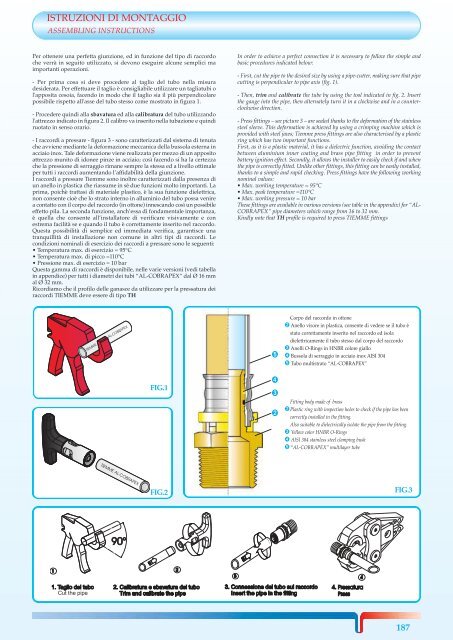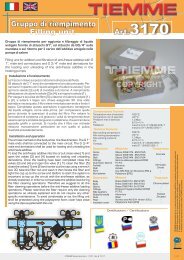raccordi a pressare per tubo multistrato “al-cobrapex” acqua e gas
raccordi a pressare per tubo multistrato “al-cobrapex” acqua e gas
raccordi a pressare per tubo multistrato “al-cobrapex” acqua e gas
You also want an ePaper? Increase the reach of your titles
YUMPU automatically turns print PDFs into web optimized ePapers that Google loves.
ISTRUZIONI DI MONTAGGIO<br />
ASSEMBLING INSTRUCTIONS<br />
Per ottenere una <strong>per</strong>fetta giunzione, ed in funzione del tipo di raccordo<br />
che verrà in seguito utilizzato, si devono eseguire alcune semplici ma<br />
importanti o<strong>per</strong>azioni.<br />
- Per prima cosa si deve procedere al taglio del <strong>tubo</strong> nella misura<br />
desiderata. Per effettuare il taglio è consigliabile utilizzare un tagliatubi o<br />
l'apposita cesoia, facendo in modo che il taglio sia il più <strong>per</strong>pendicolare<br />
possibile rispetto all'asse del <strong>tubo</strong> stesso come mostrato in figura 1.<br />
- Procedere quindi alla sbavatura ed alla calibratura del <strong>tubo</strong> utilizzando<br />
l'attrezzo indicato in figura 2. Il calibro va inserito nella tubazione e quindi<br />
ruotato in senso orario.<br />
- I <strong>raccordi</strong> a <strong>pressare</strong> - figura 3 - sono caratterizzati dal sistema di tenuta<br />
che avviene mediante la deformazione meccanica della bussola esterna in<br />
acciaio inox. Tale deformazione viene realizzata <strong>per</strong> mezzo di un apposito<br />
attrezzo munito di idonee pinze in acciaio; così facendo si ha la certezza<br />
che la pressione di serraggio rimane sempre la stessa ed a livello ottimale<br />
<strong>per</strong> tutti i <strong>raccordi</strong> aumentando l’affidabilità della giunzione.<br />
I <strong>raccordi</strong> a <strong>pressare</strong> Tiemme sono inoltre caratterizzati dalla presenza di<br />
un anello in plastica che riassume in sè due funzioni molto importanti. La<br />
prima, poichè trattasi di materiale plastico, è la sua funzione dielettrica,<br />
non consente cioè che lo strato interno in alluminio del <strong>tubo</strong> possa venire<br />
a contatto con il corpo del raccordo (in ottone) innescando così un possibile<br />
effetto pila. La seconda funzione, anch’essa di fondamentale importanza,<br />
è quella che consente all’installatore di verificare visivamente e con<br />
estrema facilità se e quando il <strong>tubo</strong> è correttamente inserito nel raccordo.<br />
Questa possibilità di semplice ed immediata verifica, garantisce una<br />
tranquillità di installazione non comune in altri tipi di <strong>raccordi</strong>. Le<br />
condizioni nominali di esercizio dei <strong>raccordi</strong> a <strong>pressare</strong> sono le seguenti:<br />
• Tem<strong>per</strong>atura max. di esercizio = 95°C<br />
• Tem<strong>per</strong>atura max. di picco =110°C<br />
• Pressione max. di esercizio = 10 bar<br />
Questa gamma di <strong>raccordi</strong> è disponibile, nelle varie versioni (vedi tabella<br />
in appendice) <strong>per</strong> tutti i diametri dei tubi “AL-COBRAPEX“ dal Ø 16 mm<br />
al Ø 32 mm.<br />
Ricordiamo che il profilo delle ganasce da utilizzare <strong>per</strong> la pressatura dei<br />
<strong>raccordi</strong> TIEMME deve essere di tipo TH<br />
FIG.1<br />
FIG.2<br />
In order to achieve a <strong>per</strong>fect connection it is necessary to follow the simple and<br />
basic procedures indicated below:<br />
- First, cut the pipe to the desired size by using a pipe-cutter, making sure that pipe<br />
cutting is <strong>per</strong>pendicular to pipe axis (fìg. 1).<br />
- Then, trim and calibrate the tube by using the tool indicated in fig. 2. Insert<br />
the gauge into the pipe, then alternately turn it in a clockwise and in a counterclockwise<br />
direction.<br />
- Press fittings – see picture 3 – are sealed thanks to the deformation of the stainless<br />
steel sleeve. This deformation is achieved by using a crimping machine which is<br />
provided with steel jaws; Tiemme press fittings are also characterised by a plastic<br />
ring which has two important functions.<br />
First, as it is a plastic material, it has a dielectric function, avoiding the contact<br />
between aluminium inner coating and brass pipe fitting in order to prevent<br />
battery ignition effect. Secondly, it allows the installer to easily check if and when<br />
the pipe is correctly fitted. Unlike other fittings, this fitting can be easily installed,<br />
thanks to a simple and rapid checking. Press fittings have the following working<br />
nominal values:<br />
• Max. working tem<strong>per</strong>ature = 95°C<br />
• Max. peak tem<strong>per</strong>ature =110°C<br />
• Max. working pressure = 10 bar<br />
These fittings are available in various versions (see table in the appendix) for “AL-<br />
COBRAPEX” pipe diameters which range from 16 to 32 mm.<br />
Kindly note that TH profile is required to press TIEMME fittings<br />
➎<br />
➍<br />
➌<br />
➋<br />
Corpo del raccordo in ottone<br />
➋ Anello visore in plastica, consente di vedere se il <strong>tubo</strong> è<br />
stato correttamente inserito nel raccordo ed isola<br />
dielettricamente il <strong>tubo</strong> stesso dal corpo del raccordo<br />
➌ Anelli O-Rings in HNBR colore giallo<br />
➍ Bussola di serraggio in acciaio inox AISI 304<br />
➎ Tubo <strong>multistrato</strong> “AL-COBRAPEX”<br />
Fitting body made of brass<br />
➋Plastic ring with inspection holes to check if the pipe has been<br />
correctly installed in the fitting.<br />
Also suitable to dielectrically isolate the pipe from the fitting.<br />
➌ Yellow color HNBR O-Rings<br />
➍ AISI 304 stainless steel clamping bush<br />
➎ “AL-COBRAPEX” multilayer tube<br />
FIG.3<br />
187



